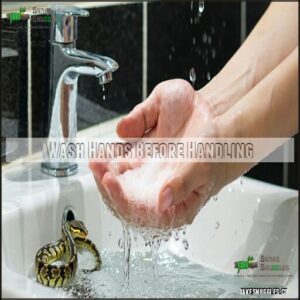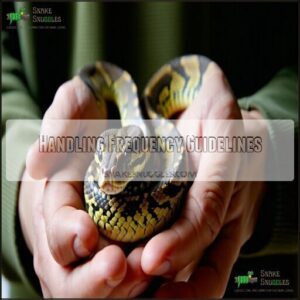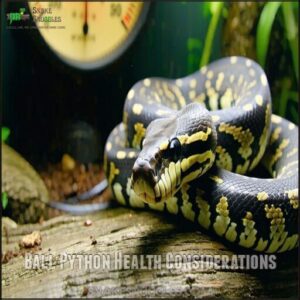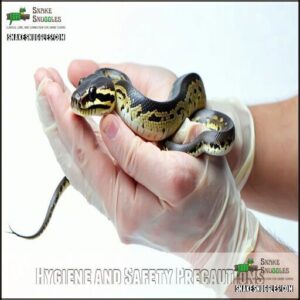This site is supported by our readers. We may earn a commission, at no cost to you, if you purchase through links.

Always wash your hands before and after to prevent bacteria transfer, and avoid mistaking your scent for food.
Move slowly and confidently, supporting the snake’s entire body to build trust.
Limit handling to 1-2 times weekly, steering clear of feeding days and shedding periods.
Watch for stress signals like head retraction or quick movements.
Start young pythons early with gentle interactions, letting them get comfortable with your presence.
Remember, each snake has a unique personality – patience is key.
Curious about deeper handling techniques that’ll make you and your slithery friend feel secure?
Table Of Contents
- Key Takeaways
- Safe Handling Techniques
- Choosing Handling Time
- Recognizing Stress Signs
- Handling Frequency Guidelines
- Ball Python Health Considerations
- Creating Trust and Socialization
- Hygiene and Safety Precautions
- Long-Term Care and Commitment
- Frequently Asked Questions (FAQs)
- How to handle a ball python safely?
- Should you wash your hands before handling a ball python?
- How do you care for a ball python?
- What happens if a ball python is handled too much?
- How often should you handle a ball python?
- How do you handle a ball python after shedding?
- Can children safely handle ball pythons?
- How do I handle an aggressive snake?
- What if my python seems uncomfortable?
- Are different handling techniques needed for size?
- Conclusion
Key Takeaways
- You’ll want to wash your hands thoroughly before and after handling to prevent bacteria transfer and ensure both your and your snake’s safety.
- Always approach your ball python slowly and confidently, supporting its entire body weight to build trust and minimize stress during handling.
- Limit your handling sessions to 1-2 times weekly, avoiding feeding days and shedding periods to respect your snake’s natural rhythms and comfort.
- Watch for stress signals like head retraction, quick movements, or heavy breathing, and immediately stop handling if you notice your snake becoming uncomfortable.
Safe Handling Techniques
When handling a ball python, you’ll want to master a few key techniques that’ll keep both you and your scaly friend comfortable and safe.
Slowly and steadily wins the snake’s trust—gentle handling transforms fear into friendship.
By learning to approach slowly, support its body weight, and move with calm confidence, you’ll build trust and create a positive handling experience.
That minimizes stress for your snake.
Wash Hands Before Handling
Every time you handle your ball python, your first defense is clean hands.
Preventing salmonella and reducing bacteria starts with thorough hand washing before and after snake interactions. Using antibacterial soap, scrub for at least 20 seconds, paying attention to fingernails and between fingers.
This important step minimizes zoonosis risks and maintains critical hygiene standards for both you and your scaly friend.
Regular terrarium spot-cleaning is also essential for hygiene.
Approach Snake Slowly
After washing your hands, take a calm approach when meeting your ball python.
Move slowly and predictably to reduce stress, avoiding sudden movements that might startle your snake.
Think of yourself as a gentle giant—your snake needs to feel safe.
A slow, deliberate path toward the enclosure signals you’re a trustworthy companion, not a predator waiting to strike.
Support Snake’s Weight
After gently approaching your ball python, proper body support becomes your golden rule.
You’ll want to cradle its entire length with both hands, distributing weight evenly to prevent strain.
Think of it like holding a delicate treasure—one hand near the head, another mid-body.
This technique guarantees your snake feels secure and comfortable during safe handling, minimizing stress for both of you.
Avoid Sudden Movements
How can you keep your ball python calm during handling?
Sudden movements are a major no-no in safe snake handling. Here’s why:
- Startling movements trigger defensive instincts
- Rapid actions increase snake stress levels
- Unpredictable gestures make pythons feel threatened
- Quick motions can provoke potential striking behaviors
Your steady, gradual approach assures a gentle interaction that builds trust and keeps both you and your ball python feeling secure.
Choosing Handling Time
You’ll want to be strategic about when you handle your ball python to make certain both your safety and your snake’s comfort.
By timing your interactions carefully and avoiding handling during sensitive periods like post-feeding or shedding, you’ll build trust and minimize stress for your scaly companion.
Avoid Handling After Meals
After mastering safe handling basics, you’ll want to pause before picking up your ball python post-meal.
Wait 48-72 hours to prevent potential regurgitation risks and support proper digestion.
Your python needs uninterrupted time to process its food comfortably.
| Feeding Stage | Handling Recommendation |
|---|---|
| Immediately After Meal | Hands Off! |
| 24 Hours Post-Feeding | Still Waiting |
| 48 Hours Post-Feeding | Cautious Approach |
| 72 Hours Post-Feeding | Safe to Handle |
| Beyond 72 Hours | Normal Interaction |
Avoid Handling During Shedding
After giving your ball python its meal, you’ll want to sidestep another handling pitfall: the shedding period.
During this vulnerable time, your snake’s vision becomes cloudy and its skin sensitive. Handling risks skyrocket, potentially causing skin irritation and massive stress.
Let your ball python navigate its shedding cycle undisturbed, ensuring a smooth, comfortable transformation.
Inadequate humidity can lead to incomplete shedding, so maintain proper enclosure conditions.
Handle 1-2 Times a Week
After completing the shedding phase, you’ll want to establish a balanced ball python handling schedule.
Aim for 1-2 weekly interactions that match your lifestyle and your snake’s comfort.
These consistent handling sessions build trust without overwhelming your scaled friend.
Short, predictable encounters help reduce stress and strengthen your bond, making each interaction a positive experience for both of you.
Recognizing Stress Signs
Learning to recognize stress signs in your ball python is key for maintaining a healthy, trusting relationship with your scaly companion.
When you know how to spot subtle changes in your snake’s body language, you’ll be better equipped to handle them safely and keep both you and your python feeling comfortable.
Head Retraction Signals
Most ball pythons reveal their discomfort through head retraction, a critical fear indicator in snake handling techniques.
When your snake pulls its head away, it’s signaling stress or potential anxiety.
These immediate actions require careful observation and gentle handling adjustments.
By understanding these preventative measures, you’ll create a safer, more comfortable interaction that respects your snake’s body language.
Quick Crawling Suggests Fear
When your snake-companion’s stress dance unfolds through quick crawling, you’re witnessing fear indicators that demand immediate attention.
Here’s how to interpret these movement signals:
- Stop handling immediately
- Return snake to its enclosure
- Assess environmental triggers
- Check recent changes
- Provide calm, quiet space
Reducing anxiety starts with understanding.
Your gentle approach can transform fear into trust during ball python handling sessions.
Heavy Breathing Indicates Stress
Rapid, shallow breaths might signal your python’s distress.
When you notice heavy breathing, it’s a red flag for stress levels that need immediate attention. Your snake is fundamentally sounding an alarm about its environment or handling experience.
| Stress Indicator | Potential Cause |
|---|---|
| Heavy Breathing | Handling Aftermath |
| Panting Behavior | Environmental Factors |
| Elevated Respiration | Health Implications |
Understanding these stress signs helps you become a more responsive and attentive python parent.
Handling Frequency Guidelines
When handling your ball python, it’s important to understand how often and when to interact with your scaly companion.
You’ll want to aim for 1-2 gentle handling sessions per week, always waiting 48-72 hours after feeding and being mindful of your snake’s age and individual temperament.
Handle Adult Ball Pythons
When stress signals fade and your python seems calm, you’re ready to master adult python handling techniques.
Start with 1-3 weekly sessions, keeping each under 30 minutes.
Let your snake guide the interaction, supporting its full body weight and moving slowly.
Remember, consistent, gentle handling builds trust and helps prevent defensive bites while encouraging a relaxed temperament. Consistent, gentle handling builds trust and helps prevent defensive bites while encouraging a relaxed temperament.
Handle Young Ball Pythons
Your young ball python needs gentle, strategic handling to build trust.
Start socializing hatchlings once they consistently eat, keeping initial sessions short and positive.
Approach slowly, supporting their entire body with calm, steady movements.
Handle juvenile pythons about once a week, letting them explore and get comfortable with your presence.
Early, patient interaction creates a confident, friendly companion.
Wait 48-72 Hours After Feeding
Waiting after feeding prevents digestion interference with your ball python.
Give your snake 48-72 hours to fully process its meal before handling, reducing regurgitation risks and handling stress.
This important pause allows proper nutrient absorption and keeps your python comfortable, ensuring a safer, smoother interaction during your ball python handling routine.
Ball Python Health Considerations
When caring for your ball python, you’ll want to stay vigilant about its overall health and well-being.
By understanding the signs of illness, monitoring physical changes, and providing consistent, attentive care, you can guarantee your scaly friend stays happy and thriving throughout its potentially 30-year lifespan. Attentive care can guarantee your scaly friend stays happy and thriving throughout its potentially 30-year lifespan.
Monitoring Physical Health
When handling your ball python, keep your eyes peeled for health clues hidden in plain sight. Your hands are powerful health monitoring tools that can reveal early warning signs.
- Check skin condition during each interaction
- Note any unexpected weight changes
- Observe breathing patterns carefully
- Gently assess for lumps or abnormalities
- Track body language for subtle shifts
A quick once-over can catch potential issues before they become serious problems. You can find necessary reptile products online.
Recognizing Signs of Illness
Something’s off with your snake, and you’ll want to catch it early.
Watch for lethargy, reduced appetite, and unusual weight loss.
Check for respiratory issues like wheezing or bubbling nostrils.
Inspect skin for abnormalities such as discolored scales or fluid-filled blisters.
Any unusual signs warrant a vet visit to prevent disease transmission and guarantee your python’s health.
Healthy ball pythons typically lie flat, so observe them for signs of abnormal body postures.
Providing Proper Care
Your ball python’s health hinges on proper care beyond just handling.
After spotting potential illness, focus on thorough maintenance.
Here’s your roadmap to first-rate ball python wellness:
- Monitor temperature gradients in the enclosure
- Maintain consistent humidity levels
- Provide balanced, species-appropriate nutrition
- Schedule regular veterinary checkups
By mastering these safe snake handling techniques, you’ll assure your scaly friend thrives.
Creating Trust and Socialization
Building trust with your ball python requires patience, consistency, and a gentle approach that helps your snake feel secure.
By creating a calm handling routine and respecting your snake’s comfort level, you’ll gradually transform a potentially nervous reptile into a confident, sociable companion.
Start Handling Early
The art of early socialization transforms ball python hatchlings into docile companions.
By introducing gentle handling techniques during their first weeks, you’ll build confidence and reduce fear.
Start slow, be consistent, and watch your snake develop a calm temperament.
Remember to watch for visible stress signals during these initial interactions. Patience is key in forming positive habits that’ll make safe snake handling feel natural for both of you.
Place Hand in Enclosure
After introducing your snake to handling basics, your next move is strategic scent familiarization.
Gently place your hand inside the enclosure, allowing your ball python to explore and investigate without pressure. Your patience builds confidence and reduces fear.
- Move slowly and deliberately
- Let the snake approach you
- Keep hand movements smooth
- Maintain a calm environment
- Respect the snake’s personal space
Your gentle approach transforms potential anxiety into curious interaction, mastering safe ball python handling techniques.
Create Handling Routine
Once you’ve introduced your hand to your ball python, create a consistent handling schedule that respects their individual temperament.
Start with short, 10-15 minute sessions once or twice weekly.
Gradually build trust through positive reinforcement, noting how your snake responds.
A predictable handling routine helps your python feel secure and develops a stronger bond between you and your scaly companion.
Hygiene and Safety Precautions
When handling your ball python, you’ll want to prioritize both your safety and the snake’s well-being by practicing thorough hygiene and careful handling techniques.
By washing your hands thoroughly, recognizing stress signs, and moving slowly and confidently, you’ll create a secure environment that keeps both you and your scaly friend comfortable and healthy.
Wash Hands Thoroughly
After building trust with your ball python, protecting both of you starts with clean hands.
Preventing salmonella requires thorough handwashing with soap and warm water before and after handling.
Scrub for at least 20 seconds, removing dirt and bacteria. For effective hygiene, consider various hand soap options.
Eliminating potential scents keeps your snake calm and reduces the risk of unwanted bacterial transfer during interactions.
Use Hand Sanitizer
After scrubbing your hands clean, reach for that hand sanitizer to eliminate lingering bacteria.
Proper sanitizer use keeps both you and your ball python safe.
Here’s how to sanitize like a pro:
- Choose an alcohol-based sanitizer (at least 60% alcohol)
- Apply a quarter-sized amount
- Rub thoroughly between fingers
- Cover entire hand surface
- Let air dry completely
It is also important to know about snake bite symptoms for your safety.
Wear Safety Gloves
When handling your ball python, opt for safety gloves that provide bite protection without sacrificing tactile sensation.
Leather or nitrile gloves can shield you from defensive strikes while allowing confident interaction.
Choose thin, flexible options that won’t restrict movement, and remember to replace contaminated gloves immediately to maintain hygiene during snake handling.
Consider buying python gloves for added safety.
Long-Term Care and Commitment
When you welcome a ball python into your home, you’re signing up for a decades-long adventure that requires careful planning and dedicated care.
You’ll need to be prepared for a potential 30-year commitment, ensuring your scaly friend receives consistent, high-quality care throughout its entire life.
Plan for 30-Year Commitment
After mastering hygiene protocols, you’ll need to think bigger.
Ball pythons aren’t weekend pets—they’re 30-year companions.
Consider long-term costs, changing lifestyles, and potential future relocations.
Who’ll care for your snake if you can’t? Identify a successor caregiver, create a responsible rehoming plan, and budget for decades of specialized care.
Ethical reptile ownership means planning beyond today.
Ensure Safe Environment
Every responsible ball python owner knows a safe environment is the cornerstone of excellent reptile care.
Creating an ideal habitat requires strategic planning and consistent maintenance.
Here are five critical elements for ensuring your snake’s well-being:
- Maintain impeccable terrarium ventilation
- Select appropriate substrate for humidity control
- Implement systematic waste removal protocols
- Apply thorough disinfection methods
- Schedule regular veterinary check-ups
Your python’s health depends on your commitment to these fundamental safety practices.
Teach Responsible Ownership
Protecting your ball python’s future means teaching kids more than just handling techniques.
Educate your family about ethical reptile care, long-term commitment, and backup plans.
Involve children in responsible ownership by explaining the 30-year journey ahead, sharing knowledge about safe ball python handling, and creating a supportive care network that prioritizes the snake’s well-being.
Frequently Asked Questions (FAQs)
How to handle a ball python safely?
You’ll want to move slowly, support the snake’s body with both hands, and wash up before and after.
Keep sessions short, watch for stress signs, and let the python explore you calmly and confidently.
Should you wash your hands before handling a ball python?
Picture your hands as potential bacteria highways before meeting your slithery friend.
You’ll want to wash thoroughly with soap and water to prevent salmonella transfer and keep both you and your ball python healthy and safe.
How do you care for a ball python?
You’ll need a proper enclosure, consistent temperature and humidity, and a balanced diet of appropriately sized rodents.
Handle your ball python gently, respect its needs, and maintain a clean habitat for a healthy, happy snake.
What happens if a ball python is handled too much?
If you handle your ball python too often, it’ll become stressed, potentially refusing food, hiding more, and exhibiting defensive behaviors.
Excessive handling disrupts its natural rhythm and can lead to health complications and decreased trust. Decreased trust is a serious issue.
How often should you handle a ball python?
Buckle up for snake-handling wisdom!
You’ll want to cuddle your ball python 1-3 times weekly, keeping sessions under 30 minutes.
Always wait 48-72 hours after feeding, and respect your serpent’s mood for stress-free bonding.
How do you handle a ball python after shedding?
After your ball python sheds, wait 24-48 hours before handling.
Gently approach from the side, support its entire body, and move slowly.
Let it get comfortable with your presence before picking it up.
Can children safely handle ball pythons?
You’ll want to supervise children closely when handling ball pythons.
Teach gentle techniques, confirm calm environments, and limit interactions to short, supervised sessions.
Always prioritize both the snake’s and child’s safety through careful guidance.
How do I handle an aggressive snake?
Stay calm and assess the snake’s body language.
Avoid sudden movements, use a snake hook for initial control, and wear protective gloves.
Move slowly, speak softly, and retreat if the snake shows signs of high aggression or striking.
What if my python seems uncomfortable?
Feeling nervous about your python’s discomfort?
If your snake seems stressed, stop handling immediately.
Back off slowly, respect its space, and try again later when it’s calmer and more receptive to interaction.
Are different handling techniques needed for size?
You’ll need different grip and support techniques for smaller versus larger pythons.
Smaller snakes require gentle, delicate handling, while larger ones demand full-body support and careful weight distribution to guarantee both your and the snake’s comfort. Smaller snakes
Conclusion
Ultimately, mastering ball python handling techniques isn’t rocket science from the Stone Age—it’s about patience, respect, and understanding.
You’ll build an incredible bond by following safe handling strategies and recognizing your snake’s unique personality.
Whether you’re a newbie or seasoned owner, prioritizing ball python handling techniques means creating a trusting relationship.
Remember, every interaction is a chance to strengthen your connection and guarantee your scaly companion feels secure and loved.
- https://community.morphmarket.com/t/to-handle-or-not-to-handle-that-is-the-question/42388
- https://www.reddit.com/r/ballpython/comments/shz11z/how_do_you_get_a_snake_used_to_being_handled_more/
- https://www.proherper.com/en/knowledge/blog/ball-python-handling
- https://pethelpful.com/reptiles-amphibians/ball-python-care-sheet-how-to-properly-care-for-a-ball-python
- https://www.quora.com/How-do-I-keep-a-ball-python-from-being-defensive



















